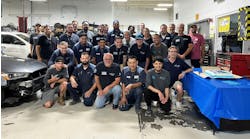The proper mix of work is essential
I knew that on the surface Long was right, but there had to be more to it than that. There were always hidden wisdom in his words. You just had to probe further and listen intently to get the answer. The veiled message was this. Control as much as you can, but do not get "wrapped around the axle" with the issues you can't control.
So, what can be controlled in the collision repair process and what can't? The answer to that question also is the source to continuous improvement. Many of us have tinkered with this source in a variety of ways: 5S, blueprinting, work teams, pay plans, shop layout and countless other innovations. Some have achieved tremendous operational gains for these efforts. A friend and colleague of mine, Michael Giarizzo Jr. of DCR Systems, started with a blank sheet of paper to design and simplify collision repair in a revolutionary fashion by using lean manufacturing methodology. The results were an unprecedented collision model providing some incredible results.
Many operations today simply do not have the desire, ability or cash reserves to completely overhaul their current model and start from scratch. However, they have another option, namely, controlling their level of work in process (WIP). WIP in a majority of shops is too high and masks or creates inefficiencies in their processes and additional expense for the business. Let's look at how you can measure your shop's WIP and adjust it to create the most profitable mix of work.
Fantastic formula
In today's tough economic times, your first response to addressing WIP probably is, "I wish work in process was my biggest concern!" Regardless of how much work you have, maximizing the results for the effort you put in is always your most prudent goal.
One notion that amuses me is the "in Monday – out Friday" principle. Most shops schedule in most of their work for Monday mornings with the primary goal of getting this work out the door on Friday evenings. I've never been able to understand why a majority of shops can deliver more cars on the last day of the month or a day before a holiday, when those days don't fall on Friday. Why can't we treat each day like it is the last day of the week or month?
Ideally, we should be able to load the same number of jobs into production as we deliver each day, while maintaining a relatively even amount of work in process. The problem in the collision industry is that we are faced with many challenges that do not allow for a "perfect world" scenario. Still, we can create a realistic work picture and go from there.
The definition of WIP can vary from one organization to another. For our purposes, think of all the jobs you have on site as WIP. WIP is inventory that you invest in from the time a vehicle becomes a repair order until the time payment is received.
The investment is not only in production labor, parts, paint and materials. You also invest heavily in administration expense, along with equipment, computer technology and the real estate the job occupies when it is on premises. Important here: The shorter the WIP time span, the higher the return on investment.
A while back I had the opportunity to work with a top university and some academically gifted individuals of a much higher intelligence than me. I asked these scholars to look at my data and theories to see if they could help me.
The first step in most academic approaches is to prove theories and solutions in mathematical form. Fortunately the folks I was working with took pity on me. Their answer wasn't a long list of statistical formulas. In fact, the formula for optimum WIP was simply this:
Daily Throughput X Cycle Time = WIP
Once it was laid out in front of me, I slapped my forehead (it was so simple, why hadn't I figured it out on my own?). Daily capacity is set by your hours of operation, number of techs, facility and equipment. If I had a goal for cycle time and managed my production to achieve my daily goal, my optimum WIP was easy to calculate.
I still needed to repeat the theory to the scholars to make sure I truly understood. I raced up to the whiteboard with a marker in my hand and began, "Let's say I have a shop that is staffed and equipped to repair four vehicles a day and my average repair order (RO) is $2,000. Let's also assume my goal for average cycle time is 9 Days."
I wrote the following on the board:
Daily Throughput 4 (vehicles per day) X $2,000 (avg. RO) = $8,000
Daily Throughput X Cycle Time = WIP
$8,000 X 9 = $72,000
"My optimum WIP in this scenario would be $72,000" I proclaimed, feeling like I'd just solved world hunger. They all smiled at me like an elementary school teacher does when a child solves a basic math problem.
Note: Many collision shops measure cycle time and WIP differently from what I've used in the previous examples. For instance, some shops and insurance companies measure hours per day instead of cycle time days. Still, the principles do not change to establish a WIP target goal. You just convert the data to the required method of measurement.
Balancing act
I still needed to assure myself I had the concept down so I continued. "If WIP increased in situations that were beyond my control, to reduce it I would increase the shift hours of my production staff to increase my daily throughput until my WIP was back to optimum levels." Again the faint smiles and nods, however I convinced myself they were somewhat as impressed with my newfound wisdom as I was.
Now I was concerned with another issue. Most of the managers and owners I work with are visual learners. What could I use to successfully explain this theory if the mathematical formula was confusing or didn't resonate with the learning style?
One of the scholars drew on the white board what resembled the following diagram:Examine the diagram, and think of it representing a scale. This scale is level since the shop has achieved its optimum WIP. Note what would happen if the number of incoming vehicles exceeded the number of delivered vehicles. The left side of the scale gets bigger. It "outweighs" the right side. The amount of WIP has increased.
To return the balance, you would have to move the fulcrum (the triangle representing cycle time) to the left. This move to the left would represent an increase in cycle time due to the increase in WIP. In this scenario, a shop may have more work, but the increased work is now impacting delivery. Longer cycle times translate into bigger costs and shrinking profits. In simple terms, if you bring more work in than you can get out, your WIP and cycle time increases.
Most shops, especially in today's economy, want to get as many vehicles in the door as soon as possible and understandably so. As this diagram shows, more work can create greater costs. To lower cycle time, you must either bring in less work or increase your output. Adding production staff to increase the amount of deliveries is usually a short-term fix. Increasing the length of the work shift until WIP is reduced to acceptable levels is normally the best approach.
Final word: When the lights come on
After many experiences using this material, I now understand the amused smiles of the people who introduced me to this notion. Now, I'm seeing the "lights come on" with numerous clients and seminar students experiencing the same realizations I had.
There's still plenty of work to be done after you understand this concept. You still need them to set the goals and standards you want to achieve. Being able to determine your optimum WIP doesn't fix vehicles any faster. However it does help you establish a target to work towards.
If you are monitoring WIP and executing strategies to maintain or lower a target WIP while achieving or exceeding deliveries, you will reduce cycle times. Understanding the cause and effect of WIP management will help you get past a lot of pre-conceived notions on how to manage the repairs in your shop. Working with a lower WIP number than you currently have, while simply maintaining your current sales, will not only improve your cycle time, it also will improve the number of times you turn over your inventory, which results in improved cash flow.
In today's competitive market and tough economic times, who doesn't want to fix vehicles faster, reduce stress and improve both gross profits and cash flow?
A cycle of failure
Pairing your understanding of WIP with blueprinting could pave the way to a serious bump in your profits. Ignoring the two might prove fatal.
When a job is blueprinted, every labor task and part necessary to complete the job is identified prior to the vehicle being entered into production. The blueprint is also used to order the correct repair parts, which are then received and verified before the vehicle is put into production. When blueprinting is done correctly, the vehicle will go through each step of the repair process without delay.
Too frequently shops create a preliminary estimate/repair plan and make corrections (create supplements) throughout the repair process as missing items are identified. Putting a vehicle into production without identifying all the necessary repair functions and receiving the required parts, results in most jobs being set aside to wait for repair authorizations, administration processing or parts at some point during the repair. Subsequently, another vehicle is put into production, which creates more WIP. This vehicle then is processed until the discovery of undocumented repairs or other interruptions, creating more WIP and further increasing cycle times.
Eventually, authorizations and parts are received, and the shop begins prioritizing which job goes in front of the other based on outside influences, promises and internal politics. All these delays again increase WIP, which in turn creates higher cycle times.
Double dose of success
Carl Kupbens, manager of Capitol Collision in San Jose, Calif. had the same problem many high volume shops share and one many shops wished they had. Excess square footage in his shop permitted technicians to have multiple work bays. Greater numbers of work bay frequently produces higher WIP and cycle times. Capitol was no exception.
Kupbens and his team embraced blueprinting of repairs, which significantly improved throughput and help lower WIP by 25 percent. During this process improvement, Capitol was able to maintain sales in a tough economy and reduce cycle times from an average of 7 to 3.5 days. The repair hours produced per day on each vehicle improved from 2.8 to 5.6 hours. The shop improved its gross margin without reducing shift hours or staff. This is an impressive achievement, however not an isolated case.
Kupbens notes, "When I was made aware of the excess inventory sitting around in my shop it drove me crazy. I couldn't believe the difference in the way vehicles moved through production and how much more additional time my administrative staff had to do their work."
He adds, "My staff was eager to embrace this new way of doing things and we wouldn't have had the success without their co-operation."
The solution was
The results and explan
When I work with shop owners and managers we typically break up the WIP into two separate areas; Blueprint, from vehicle arrival on the premises to what we determine as production ready, and Production, from entering production to ready for delivery.
Cycle time goals are established for each area and proactively managed accordingly to meet delivery times.



